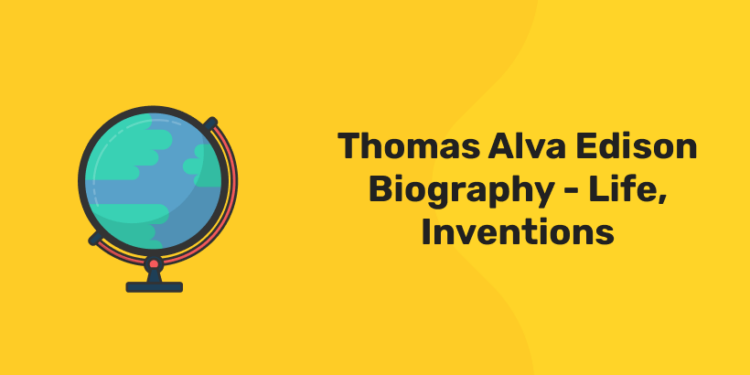Table of Contents
Thomas Alva Edison was one of America’s greatest inventors, with several patents, the most of which were linked to electricity and power. While the incandescent light and the phonograph are two of his most recognized innovations, large-scale organised research is undoubtedly Edison’s most important creation.
Life of Thomas Alva Edison
Thomas Alva Edison was one of the most well-known and prolific inventors of all time, contributing inventions such as the incandescent light bulb, the phonograph, and the motion picture camera, as well as enhancing the telegraph and telephone. He accumulated 1,093 patents throughout his 84 years of life. Edison was not just an inventor, but also a great producer and businessman who sold his products to the general public. Edison’s life was packed with a plethora of commercial relationships, partnerships, and corporations, as well as ongoing legal disputes over patents and corporations. The following is simply a sliver of an extremely busy and complex life filled with multiple projects, many of which are ongoing at the same time.
Download Entri App to attempt GK Mock Test!
Early Years of Thomas Alva Edison
1: Who was the first woman President of India?
Thomas A. Edison’s ancestors lived in New Jersey until the American Revolution, when their loyalty to the British crown pushed them to Nova Scotia, Canada. Later generations moved to Ontario, where they fought the Americans in the War of 1812. Nancy Elliott, Edison’s mother, was born in New York and migrated to Vienna, Canada with her family, where she met and married Sam Edison, Jr. Sam was compelled to flee to the United States after becoming embroiled in a failed insurgency in Ontario in the 1830s.
On February 11, 1847, in Milan, Ohio, Thomas Alva Edison was born to Sam and Nancy. Edison, who was known as “Al” as a child, was the youngest of seven children, four of whom lived to adulthood. When he was younger, Edison was prone to illness.
In 1854, Sam Edison and his family relocated to Port Huron, Michigan, where he worked in the lumber industry.
Edison struggled in school. When Edison’s mother became enraged because a teacher dubbed him “addled,” she yanked him out of school and began tutoring him at home. Many years later, Edison claimed, “My mother was the one who gave birth to me. She was so certain of me, and I felt like I had someone to live for, someone I couldn’t let down.” 1 He was fascinated by mechanical objects and chemical experiments from an early age.
Edison lost almost all of his hearing at the age of twelve. There are a few ideas as to why he lost his hearing. Some blame it on the symptoms of scarlet fever, which he contracted as a child. Others attribute it to a conductor covering his ears after Edison set fire to the baggage car, an occurrence Edison claimed never occurred. Edison himself attributed it to an incident in which he was hoisted onto a train by his ears. He did not let his condition deter him, and in fact, he saw it as a benefit because it allowed him to focus more easily on his trials and study. His deafness, on the other hand, made him more lonely and shy in social situations.
Thomas Alva Edison’s inventions
In many situations, Edison’s brilliance was in adopting a new technology that had been pioneered by someone else and finding a better way to achieve the same thing.
Some of Edison’s most important innovations are listed below.
Automatic Telegraph
While Samuel Morse’s creation of the telegraph in the 1830s and 1840s made it feasible to communicate over large distances for the first time, the system was not without flaws. A Morse code operator had to listen to incoming dots and dashes, which slowed messages to 25 to 40 words per minute. Only 120 words were achieved using a British technique for automatically producing code in ink on paper.
Between 1870 and 1874, Edison created a far superior method in which a telegraph receiver used a metal stylus to mark chemically treated paper, which could then be fed through a typewriter-like mechanism. It had a recording speed of up to 1,000 words per minute, allowing it to convey long messages fast.
Carbon Telephone Transmitter
He devised the Carbon Microphone and Carbon Button Transmitter in 1877, which were crucial to the telephone’s success. “Alexander Graham Bell invented the telephone, but it was Edison who invented the microphone, which transformed the telephone from a potential toy into a necessary machine with real-world uses.”
The Light Bulb
Edison did not, according to popular opinion, invent the incandescent light bulb. He did, however, invent and market a design that was the first to be long-lasting enough to be useful in everyday life.
Edison created a vacuum bulb in the late 1870s, in which a metal filament could be heated to produce light. He received the idea for switching to a carbonised filament after accidentally rolling a bit of lampblack, the material he used in his telephone receiver, between his fingers one night. He began experimenting with other materials after first using carbonised cardboard, and eventually landed on bamboo, which had long fibres that made it more durable. Eventually, Edison was able to enhance the lifetime of bulbs to around 1,200 hours by combining bamboo filaments with a better vacuum pump that eliminated air more effectively.
Phonograph
Edison had the idea for a system that could record and play back telephone messages while working on his telephone transmitter. That idea led him to imagine being able to record not only speech but also music and other sounds by using sound to shake a diaphragm and drive a stylus into indentations on a cylinder covered in wax paper and rotated by a crank.
Edison’s phonograph was a hit, and it helped cement his reputation as a brilliant inventor. He eventually began marketing and selling the machines and cylinder records, reverting to wax once more. However, by the early 1900s, disc phonographs from the Victor Talking Machine Company had exceeded Edison’s cylinder phonographs in popularity. Despite the fact that cylinders generated higher-quality sound, early discs had a significant advantage in that they could hold four minutes of music vs two minutes on a cylinder.
Alkaline Storage Battery
Edison’s innovation in 1906 was a big step forward in alkaline battery technology. He noticed sulphides in the battery solution because of the rubber insulators and supports on the battery. As a result, Edison created a new alkaline battery with desulphurized rubber insulators to boost efficiency and longevity.
Edison was a prolific inventor, receiving 147 patents for battery-related inventions during his career. Thanks to Edison and a huge number of scientific pioneers like him, we now find ourselves in an exciting moment of time where these battery technologies continue to be improved and widely used to increase grid dependability and emissions reductions.
Movie Camera and Viewer
Edison oversaw the creation of a device “that accomplishes for the vision what the phonograph does for the ear” in his lab in the late 1880s. Edison’s employee William Kennedy-Laurie Dickson did the majority of the work on the Kinetograph, an early movie camera, and the Kinetoscope, a single-person peephole movie viewer. Movies grew in popularity, and developments such as the Lumière Cinématographe swiftly superseded Edison’s camera and viewer a camera, printer, and projector that allowed multiple people to watch a movie at the same time. But Edison adjusted, and his studio grew into a flourishing early cinema studio, producing dozens of silent films between the 1890s and 1918, when it ceased production.
Thomas Alva Edison’s Quotes
- “Our greatest weakness lies in giving up. The most certain way to succeed is always to try just one more time.”
- “I have not failed. I’ve just found 10,000 ways that won’t work”.
- “Opportunity is missed by most people because it is dressed in overalls and looks like work.”
- “Many of life’s failures are people who did not realize how close they were to success when they gave up.”
- “Your worth consists in what you are and not in what you have.”
- “Discontent is the first necessity of progress.”
- “The value of an idea lies in the using of it.”
- “The chief function of the body is to carry the brain around.”
- “Show me a thoroughly satisfied man and I will show you a failure.”
- “To have a great idea, have a lot of them.”
Attempt free GK Mock Test! Download Entri App!
Thomas Alva Edison’s facts
- Edison was classified as a “tough” student by a teacher. He only went to school for 12 weeks. After that, he was educated at home by his mother.
- Edison acquired a total of 1,093 patents for his inventions, which is a record for a single person. A patent indicates that you control the rights to an innovation and that no one else can manufacture or sell it.
- Edison lost a lot of his hearing when he was 12 years old, which was one of his many infirmities. Despite the fact that he wasn’t fully deaf, he preferred not to be able to hear in order to focus on his experiments and inventions.
- Edison began printing a newspaper on board the train he worked on when he was just 15 years old.
- Edison established a firm with the sole purpose of inventing new items. He employed people to help him develop his ideas.
- Edison’s long-time opponent was Nikola Tesla, an engineering visionary who worked for Edison’s company for a time.
- Edison preferred night shifts because it allowed him to sneak in experiments while working as a telegraph operator.
- Thomas Edison did not invent the first lightbulb; it was invented more than 50 years before he began his own business. Despite this, he was able to re-invent a bulb that generated a soft light that lasted a long time, making it practical and usable in a residential context. It was an incandescent lightbulb.













